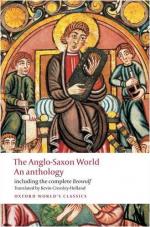
|
| Name: _________________________ | Period: ___________________ |
This test consists of 15 multiple choice questions and 5 short answer questions.
Multiple Choice Questions
1. In the stanza beginning "I'm a strange creature," what does the strange creature state it satisfies?
(a) Hunger.
(b) Women.
(c) Thirst.
(d) Cravings.
2. Whose will is the earliest surviving will of any Anglo-Saxon king?
(a) King Bede.
(b) King Solomon.
(c) King Hreather.
(d) King Alfred.
3. In "A Colloquy" what does the pupil say he prefer to ignorance?
(a) To be exiled.
(b) To be flogged.
(c) To be mute.
(d) To be imprisoned.
4. According to "The History of the English Church and People," how does Bede describe the complexions of the slaves seen by Gregory in the Roman marketplace?
(a) Darkened.
(b) Blemished.
(c) Fair.
(d) Pock-marked.
5. What is the name of "one of the most popular philosophical books of the Middle Ages"? (According to the author of the introduction.)
(a) "Intermediate Teachings of Higher Thought."
(b) "Justifications of Philosophical Thought."
(c) "Consolation of Philosophy."
(d) "Ancient Beliefs and Modern Philosophies."
6. Who raided Lindisfarne on June 8, 793?
(a) Christians.
(b) Pagan heathens.
(c) Celtic monks.
(d) Vikings.
7. Who, living between the years 955-1020, does the author of the introduction to Example and Exhortation state was the "most significant figure in this age of religious and educational reform"?
(a) Aelfric.
(b) Bede.
(c) Aristotle.
(d) Colombus.
8. Under what circumstances could a wife obtain all of the husband's suit?
(a) If she found him guilty of lechery.
(b) If they divorce, and they have a child.
(c) If she outlives him.
(d) If she outlives him, and they have a child.
9. What was the name of the monk in the monastery at Ramsey who complied a handbook on computus?
(a) Stephen.
(b) Detriech.
(c) Byrhtferth.
(d) Synthegrth.
10. Where, according to the excerpt from "The History of the English Church and People," had the slaves that Gregory saw hail from?
(a) Britian.
(b) France.
(c) Germany.
(d) Northumberland.
11. What is the traditional kenning for a wife?
(a) Child-bearer.
(b) Care-granter.
(c) Peace-weaver.
(d) Home-taker.
12. What did the runic alphabet come to be used for later (after its first use)?
(a) Christian theology.
(b) Coding.
(c) Pagan theology.
(d) Identification.
13. In what century was "An Estate Memorandum" written?
(a) 8th or 9th.
(b) 5th or 6th.
(c) 10th or 11th.
(d) 2nd or 3rd.
14. In what year was the "terrible winter" in "The Anglo-Saxon Chronicle"?
(a) 763.
(b) 847.
(c) 631.
(d) 296.
15. In "Greetings in Christ," what does the author of the section say are susceptible to the "wear and tear of centuries"?
(a) Sermens.
(b) Poems.
(c) Christian thought.
(d) Letters.
Short Answer Questions
1. At dawn what is the first thing that the ploughman does in the morning?
2. In what year did Gregory send Augustine to Kent?
3. What is the subject and tone of Anglo-Saxon riddles?
4. How many stress patterns does all Old English poetry contain?
5. Who was the godson of Aethelstan?
|
This section contains 431 words (approx. 2 pages at 300 words per page) |

|




